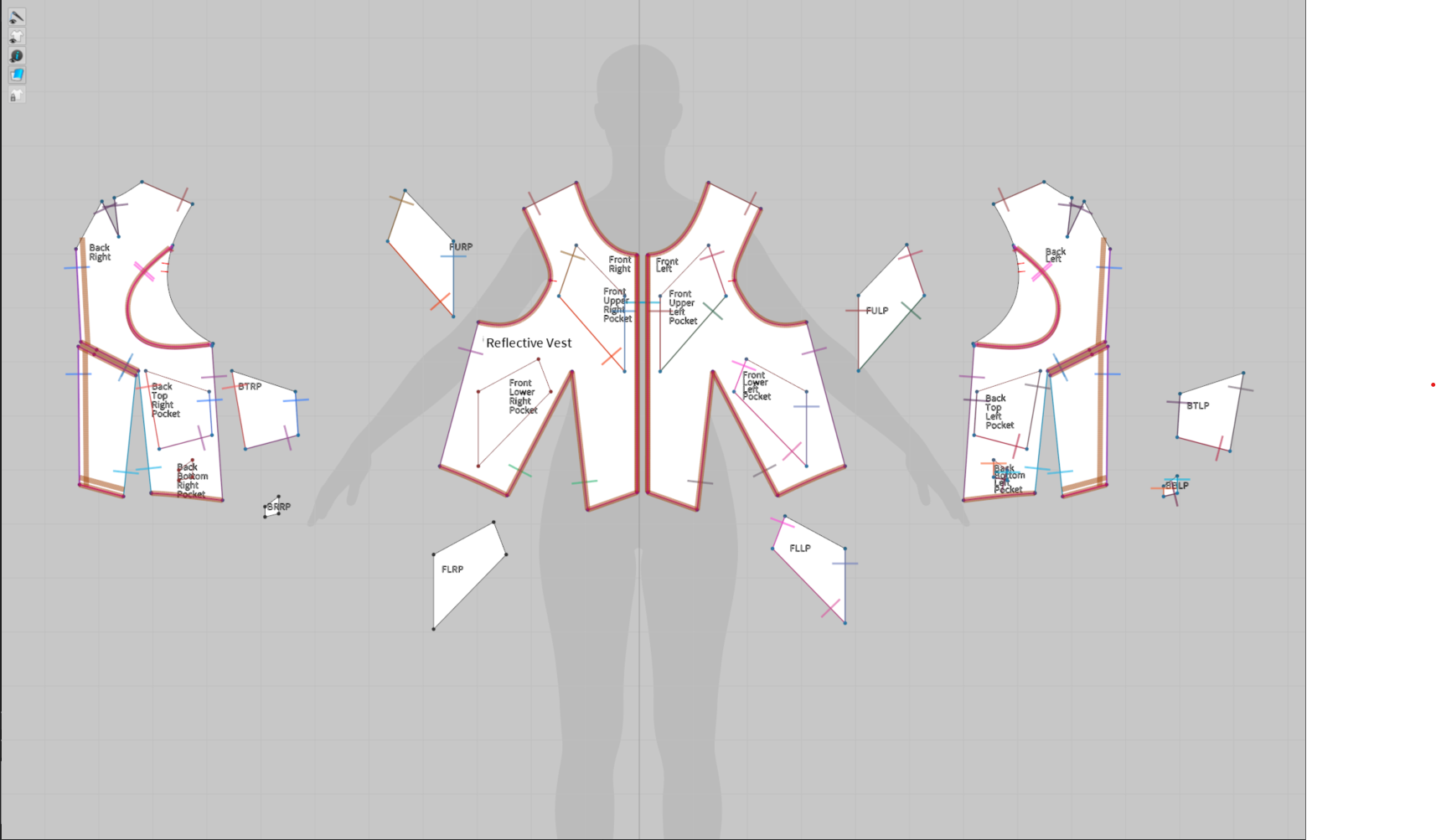Have you ever been walking on a deserted road at night and had a car suddenly come up behind you? Do you bike or walk around in a rural area in the dark from dawn to dusk, and wanted to let others know you were out there if they were headed toward you? Many automobile accidents occur when a car turns suddenly and does not see the bike/pedestrian. This vest helps keep safe from dusk to dawn using intelligent environmental sensing and solar charging. The vest responds before you do.
Our reactive safety vest is designed for comfort and utility. This safety vest works normally during the day. Its bright, fashionable colors warn oncoming traffic of your presence as it charges. Our vest is sculpted from lightweight mesh in a stylish form factor for breathability and comfort, so you can wear it all day. Your arms are free for activities.
As the darkness falls, our jacket really shines. The jacket turns on its lights adaptively. If you want to stay mostly dark, you can adjust the brightness. Our intelligent light and sound sensing will alert oncoming cars with bright flashing light patterns. But, if you're wearing headphones or distracted with your work, there are vibration alerts built in to alert you quickly of oncoming danger. There's a handy battery charging indicator to let you know the status of the vest, so you know that the safety features are working.
So we first started off with thinking about when it would be useful to have your clothes light up. Although we had worked on light-up dresses that communicated emotions like a firefly before, we wanted to find something that made use of solar power. Ordinary garden lights do a great job of keeping you safe in an ambient, safe manner. It didn't seem too farfetched to make an ambient light vest.
Of course if you're out walking Fido, you want to keep your dog safe as well. The Bekonix controller natively has Bluetooth, so it seems logical that an companion product would be a reflective, light-up vest for your dog that blinks when yours does. As this last weekend wound down we experimented with that idea. And while doing that, it makes sense that a group of people walking together should have all of their vests blink together too. The more we work with this project idea, the more that comes to mind.
Concept DesignWe created a first prototype of light triggering the LEDs. Below is a circuit that triggers when there is a sudden bright light compared to ambient light. We chose a lightweight battery pack of 3 AAAs, NeoPixel WS2812 LED Strips, a photo resistor, and the MSP430 Launchpad for prototyping. These LED Strips should be easy to swap for the NLiteNs as we get closer to manufacturing.
The circuit operates at 3.3V operating voltage, while the battery pack supplies 4.5V. The photoresistor forms a voltage divider, and ambient light fluctuations are sent to TI's analog sensing port. The MSP430 will determine whether to send a signal to the LEDs. The LEDs can be powered by the 5V pin on the Launchpad or the regulated power output supplied by the battery pack.
The circuit was ready to be put into clothing. We then had to decide where and how many LEDs would fit onto the vest. We draped it around the vest to test what would look good. It turned out that 32 LEDs on each side would give us the most light coverage. Once this was decided, attach the LEDs to the garment by creating two channels down the side of the body where they would fit. We used bias tape to create the channels.
Next step is to add the solar cells so that we can charge the circuit when we're out in the daytime. There would be four ASCA solar panels, two in the front, two in the back. We added mesh pockets to hold these solar panels, and also created a pocket for the battery and microcontroller circuit.
For this prototype, we used NeoPixel LED strips and commercial solar panels. In the production version, we'd use ASCA solar panels and NLiten LEDs. Here's what the circuit would look like.
The vest can be separated from the electronics for washing. The LEDs are in the white channels, and can be slid out. The solar panels and CPU and battery are in pockets and can be slid out.
Solar integrationWe implemented our prototype using batteries, but expect to attach to the ASCA solar films as soon as they are available. Based on our prototype design, we were planning to use four ASCA solar panels.
Some back-of-the-envelope calculations for our circuit:
Solar cells put out 10 watts per square foot. We want to charge a smallish battery in a few hours of daylight. The small battery we picked is 1.4 Ah, or 5 WH. Our panels were 4x6 inches, so 24 sq inches or 0.17 sq feet. We have 4 of those for .67 sq feet. We can then, in theory put our panels in full sun and charge the battery in the schematic in about an hour. A power output of 6.7 Watts into a 5wh battery should take 45 minutes-- but let’s call it an hour. We estimate 1/2 to 3/4 of a square foot of cells will charge our battery easily in about 2 hours of being outdoors in bright sunlight.
This would also leave plenty of power to use a LED for charging indicator, pager motor, and microphone to increase the sensing quality and user interface. If our solar cells and battery were improved, we might also add a speaker to add in an audio alert. Perhaps a chorus of kids saying "car!"
ManufacturabilityThe reactive safety vest is manufacturable on a standard industrial sewing machine with ballpoint needles. It showcases a thoughtful approach to sustainability and customization. It utilizes sustainable recycled polyamide net fabric, reducing waste while offering desirable properties such as lightweight, softness, non-absorbency, wrinkle resistance, and slight stretch.
To maximize fabric utilization and minimize waste, the vest incorporates princess seams and a center back seam, creating a tighter fabric marker. This design choice enables customization and adaptability, allowing users to personalize the vest's light channeling according to their preferences. Mathematical modeling of pattern pieces further optimizes fabric utilization.
Durability and longevity are enhanced through easily repairable features. Reinforced stitching, accessible seams, and replaceable panels make it simple for users to mend the garment instead of discarding it, reducing waste. The incorporation of repair panels and secret seams introduces innovative solutions that utilize fabric scraps for efficient repairs, ensuring prolonged wear.
Secret seams, extra seams placed in unusual locations like the side seam or concealed in the back of the armhole, allow for the utilization of fabric scraps or repairs. This technique minimizes waste while maintaining the garment's integrity, supporting sustainable practices.
Transparency and sustainability are prioritized with an informative tag providing details about the garment's materials, production processes, and recycling instructions. By combining sustainable materials, innovative seaming techniques, repairability, and transparent labeling, this design exemplifies a holistic and environmentally conscious approach to safety vest production. The customizable design further enhances its versatility and individuality and ensuring a longer wear life.
We realize that the integration of the lighting and electronics into a washable, durable piece of all-weather clothing will be the most difficult aspect of the project.
We have two conceptual approaches to integrating the lighting system into the clothing:
Technical Design Hypothesis
First, we have a concept for an edge-lit lightguide plate made of flexible, clear polymer. This material will be lasercut to any range of creative graphic patterns. It will be laser etched to properly extract the lighting uniformly across the width and length of the lightguide. The lightguide plate will be adhered to a retroreflector base material that is lasercut to match the profile, but extend beyond the lightguide to maximum apparent brightness. This lightguide will wrap around the shoulders and terminate in a hidden internal breast pocket, where it will mate with a small, thin LED + battery unit. The LEDs will edge light the lightguide plate.
Second, we could alternatively use modern ultra-narrow LED flex strips with continuous COB configuration of the phosphor. These LED flex strips will be sandwiched on a retroreflector substrate and weather-sealed under a light diffusion medium. Wiring will terminate the strips to the small, discrete batter + control pack, using something akin to a “mag safe” connector.
The solar PV cells can be segmented for flexibility and completely encapsulated in optically clear silicon for a “soft touch” feeling. Thin, fibrous “woven” PV strips might also be explored in the future for an even softer, more conforming solution.
The battery pack and electronics will be completely encapsulated, perhaps in a soft, ultra-thinsilicon pouch. Using modern Li-Po batteries, we can make this pouch mere millimeters thick for an unobtrusive placement in the garment. Using wireless charging and wireless connectivity and lightguide coupling, we can completely seal the enclosure with zero points of possible water ingress
Situational Awareness
In the prototype, we focused on integrating electronics into a safety vest to help cars become more aware of an almost invisible human in their environment Such smart wearables may be able to enhance the situational awareness by leveraging the internet of things ecosystem. External data may be used to help a wearer adapt to the environment to react to danger more quickly than a person could. Maybe the system can help you get all green lights. Essentially, because the garment can store and process data about how the vest is used within its environment, it eventually be part of a crowdsourced data ecosystem. A smart vest could help others avoid immediately other unsafe situations like spontaneous traffic jams or help guide the public by using the light patterns to respond to real time data. Cities may make data-driven improvements to enhance cyclist safety, ensuring a more secure and seamless environment for all.
Future Vision – Design Hypothesis
Our solution could be integrated into a variety of garment styles to cover a range of weather conditions, types of sports, and aesthetic options. Our solution could be incorporated into fashions ranging from soft-shell jackets to reflective mylar shells to open air mesh pieces.
If we pursue the lasercut light guide approach, a wide variety of graphic patterns could be incorporated, ranging from glowing tribal tattoos, Voronoi patterns, tessellated geometries, etc. If we pursue the LED flexstrip approach, then bold lines of light could incorporated in a variety of fashionable approaches.
But overall, we hope to forever banish the tradeoff between being safe in dark conditions and looking “cool” while doing it. The technologies available to us have finally caught up to the vision of movies like Tron: We hope to finally set a new trend in stylish illuminated athletic clothing. Both for you and your pets - you want to keep your best friend safe and stylish, right?





























Comments
Please log in or sign up to comment.